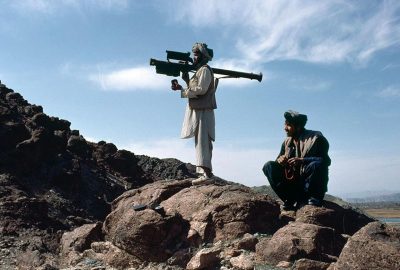Counting the Dead Through the Fog of War in Afghanistan

During one week in late September, U.S.-led forces killed at least 70 civilians in two incidents in Afghanistan. A U.S. drone strike on September 19th killed at least 30 farmers harvesting pine nuts in Nangarhar province. Then on September 23rd, at least 40 civilians, including women and children, were reported killed in a combined U.S.-Afghan attack on a village in Taliban-controlled territory in southern Helmand province.
These massacres gained some attention from the international media. But, as with mass shootings in the U.S., the way they were reported obscures the reality that these are just the bloodiest incidents in daily, systematic violence that kills thousands of people day in day out in Afghanistan and other U.S. war zones, with little Western media attention or public awareness. This is as true of the violence of endless war as it is of endemic domestic gun violence in the U.S.
In a rare and commendable effort to break through the corporate media silence and resulting public apathy, the BBC set out to track the violence of the war in Afghanistan in more detail for a single month. For the full month of August, it sent out reporters to different parts of the country, including some Taliban-held areas, and compiled their individual reports into a data-set and a published report to paint a more complete picture of life and death in America’s longest war.
The BBC counted an average of 74 men, women and children killed each day, a total of 2,307 people killed in the month of August, with another 1,948 people wounded.
The report broke down the numbers of people killed both by who they were and by how and where they were killed. The BBC classified the dead as 1,007 anti-occupation fighters (Taliban, Al Qaeda and IS), 675 government troops and police, 496 civilians and 3 U.S. troops.
The BBC was able to broadly identify how 2,089 of them were killed: 844 in armed clashes; 515 in air strikes; 255 by snipers or targeted killings; 249 in explosions; 118 by shelling; and 108 in ambushes.
The killing documented by the BBC spanned every part of Afghanistan, with the largest numbers killed in Kabul; nearby Ghazni province (the bloodiest of all, with 232 people killed in 66 attacks); and Balkh province around Mazar-e Sharif in the north.
Mohibullah, from Uruzgan province, who brought his brother to the main hospital in Kandahar with a bullet in his shoulder, angrily told the BBC, “Whenever there’s an operation in our area, ordinary people can’t move anywhere. If they do, American or Afghan forces shoot them. They drop bombs wherever they want. All the houses around us have been destroyed.”
While the BBC report reveals a more comprehensive view of the daily slaughter in Afghanistan than most media reports, it is still an incomplete picture. The BBC counted only the lowest confirmed number of people killed in each incident, dropping conflicting reports of higher casualties, and, as the report said, “hundreds of reports were excluded and the true number of attacks and casualties could be much higher.”
The BBC also noted that Afghan government forces treat their own casualty figures as secret and refused to confirm them, while the Taliban rejected the BBC’s count of its casualties as “baseless allegations” and government propaganda. The U.S. military has a long and sordid history of counting civilians it kills as enemy combatants, from Vietnam to its current wars, so the Taliban’s response is likely to be at least partially correct.
But at least the BBC tried to systematically report war-deaths from around the country in real time. The UN Assistance Mission in Afghanistan (UNAMA) has published regular reports on civilian casualties since 2007, but they have been more fragmentary and incomplete. They include only confirmed minimum numbers of civilian deaths in incidents investigated by the UN human rights office in Kabul, and only the ones for which it has been able to complete its investigations.
Fiona Frazer, the current UN human rights chief in Afghanistan, told the BBC that
“more civilians are killed or injured in Afghanistan due to armed conflict than anywhere else on Earth.” But she added that, “Although the number of recorded civilian casualties are disturbingly high, due to rigorous methods of verification, the published figures almost certainly do not reflect the true scale of harm.”
The tragedy of Afghanistan is only obscured and compounded when UNAMA’s reports, which are based on UN investigations of only a fraction of the killings taking place across the country, as Frazer acknowledged, are cited by journalists and academics around the world as if they were actual estimates of the total number of civilians killed in the war.
The number of combatants killed in Afghanistan is also largely unknown and ignored. The international media were surprised when President Ghani revealed in January 2019 that 45,000 Afghan troops and police had been killed since he took office in September 2014. If the BBC’s finding that government troops and police were about a third of the people killed in August 2019 was also true for the period Ghani referred to, total Afghan war deaths for those 52 months would have been about 130,000 to 140,000.
It is considered good journalistic and academic practice to cite the lowest confirmed numbers of deaths in armed conflicts, as the BBC did in its report, and as other journalists do in accounts of drone strikes, air strikes and other U.S. military operations. But when this practice is applied to numbers of deaths in an entire war, journalists, academics and UN and government officials also have a duty to make it clear that these are only minimum confirmed numbers and to give readers some idea what proportion of actual deaths they are likely to represent.
The war in Iraq is the only one of America’s recent wars for which more comprehensive epidemiological mortality studies have been conducted. As in wars in other countries, these studies found a scale of war deaths that is many times higher than widely published figures based on compilations of media reports, hospital records, human rights investigations and other “passive” sources.
Les Roberts, the lead author of the first Iraqi mortality study published in 2004, and of commonly referenced studies in Rwanda and the Democratic Republic of Congo (DRC), told me that serious epidemiological studies usually find that passive sources have only revealed between 5% and 20% of actual war deaths in conflict zones.
But the U.S. and U.K. governments and the corporate media did their best to “rubbish” the epidemiological studies conducted in Iraq in 2004 and 2006. This left the public so confused that opinion surveys in both the U.S. and the U.K. found that average citizens believed only 10,000 Iraqis had been killed in the war, even after the Lancet medical journal published the epidemiologists’ estimate of 600,000 violent deaths.
As the Saudi-led war in Yemen has provoked growing worldwide outrage, U.K.-based ACLED (Armed Conflict Location and Event Data Project) has stopped simply reporting the casualty figures published by the World Health Organization (WHO) and the UN, which are based on surveys of hospitals in Yemen. ACLED has instead compiled its own reports of war deaths from the beginning of the war in 2015 to the present, and its figures are now widely accepted by international media in place of the much lower UN figures. As of June 2019, ACLED counted 91,600 war deaths in Yemen. That does not include deaths from preventable diseases and food shortages in the resulting humanitarian crisis, which, as UNICEF has reported since December 2016, kill at least one child every ten minutes.
But like the BBC’s August death count in Afghanistan, ACLED’s figures from Yemen are probably still only a fraction of the actual number of people killed. Passive reporting is still just passive reporting. ACLED cannot detect every Saudi air strike or every firefight in remote areas of Yemen any more than the BBC’s reporters could detect every air strike or night raid on remote villages in Taliban-held regions of Afghanistan.
Just as a scientific mortality study was needed to reveal that about 3,000 people died as a result of Hurricane Maria in Puerto Rico, only comprehensive mortality studies can produce reliable estimates of the true scale of the slaughter in America’s endless wars. Such studies are sorely needed for Afghanistan, Yemen, Libya, Somalia, Syria and Pakistan.
Absent such studies, the BBC’s August survey in Afghanistan and ACLED’s reports on Yemen are among the most reliable reports available, but they should be referenced or cited with the clear understanding that what they report are confirmed minimum numbers of people killed. The question they leave unanswered is: what fraction of the true numbers of people killed do these reports represent?
The considerable experience of epidemiologists in war zones around the world, including in Iraq, suggests approximate answers to that question, as I have explained in my reporting on these questions over the past fifteen years. This has led me to conclude that the true death toll inAmerica’s post-9/11 wars is not in the tens of thousands, nor even in the hundreds of thousands, but in the millions.
The terrible reality that is hidden in plain sight is that America’s wars are far more deadly and destructive than widely published figures would suggest. It is therefore up to journalists, academics, activists and citizens to grasp this reality and to respond appropriately, by calling clearly and firmly for: an end to these wars; a genuine accounting of their human cost; criminal prosecutions of U.S. officials responsible for illegal attacks on foreign countries and other war crimes; and the payment of war reparations to the people and countries they have damaged or destroyed.
*
Note to readers: please click the share buttons above or below. Forward this article to your email lists. Crosspost on your blog site, internet forums. etc.
Nicolas J S Davies is the author of Blood On Our Hands: the American Invasion and Destruction of Iraq. He is a researcher with CODEPINK and a widely published independent journalist.
Featured image is from Rare Historical Photos


